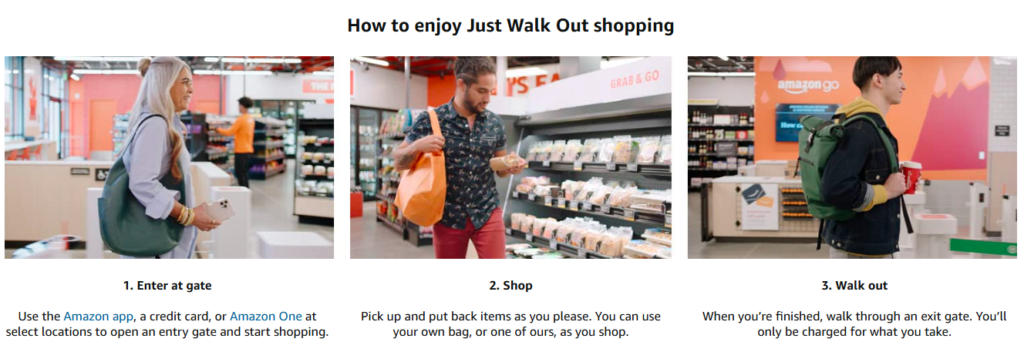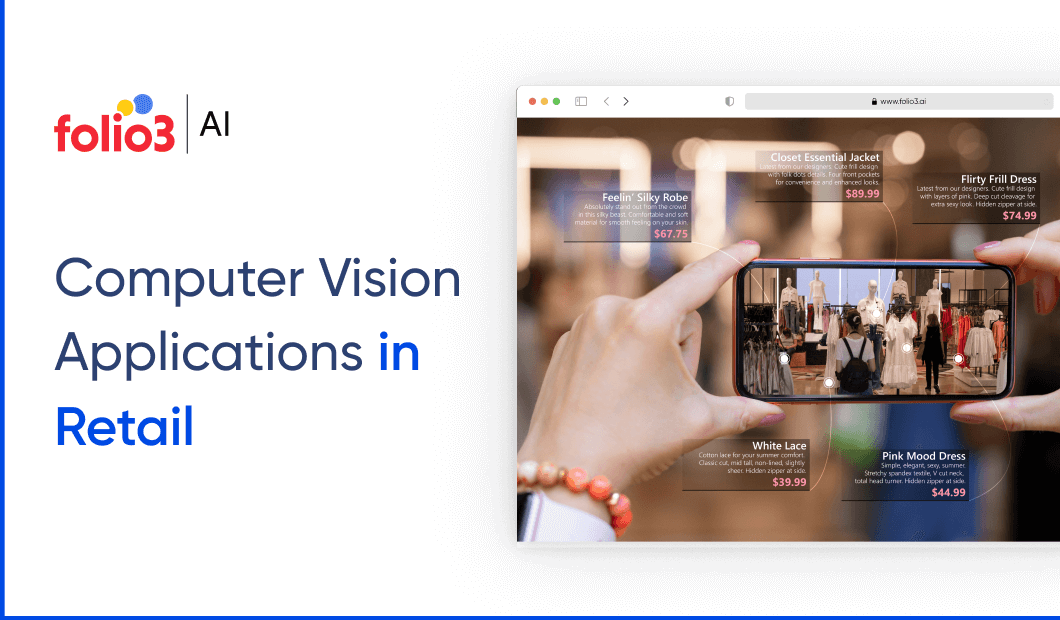A retail store is a hub where countless customers walk in, each with unique preferences and buying patterns. Every movement, from the way they browse aisles to the time they spend contemplating a product, holds valuable insights.
AI and computer vision operate this entire process. From the moment customers step in, AI-driven cameras analyze their expressions and track product interactions. Capturing these details allows retailers to refine store layouts, personalize recommendations, and create a happy shopping experience that keeps customers coming back.
Computer vision in retail allows businesses to do more than sell products; they can read customer intent, optimize store layouts, and eliminate the biggest pain points, like long waits and stock shortages. With AI-driven cameras, retailers can even detect suspicious behavior to prevent theft, while real-time analytics ensure shelves are always stocked with what customers want most.
Major retailers have already incorporated computer vision, including Amazon Go (cashier-less stores), Walmart (AI-powered self-checkout monitoring), Sam’s Club (AI-based exit technology), Kroger (smart shopping carts), and Sobeys (AI-driven checkout systems).
Read on to explore more of its key applications below.
What is Computer Vision in Retail?
Computer vision in retail refers to AI and machine learning that empowers machines, and cameras to analyze and interpret visual data from the retail environment. From detecting emotions and facial expressions to tracking movement patterns, this technology helps retailers make data-driven decisions, creating a more engaging and efficient shopping experience.
It also helps with inventory management by monitoring stock levels, optimizing store layouts by assessing customer movement patterns and personalizing marketing efforts through customer demographics and behavior analysis. Ultimately, it aims to improve operational efficiency, Improve customer satisfaction, and drive sales.
Key Applications of Computer Vision in Retail
Now, let’s look at the key applications where computer vision solutions are helping the retail industry in impactful ways.
1. Automated Checkout & Cashier-less Stores
Computer vision and machine learning have changed the dynamic of the consumer-buyer-seller journey in the retail landscape. Now we have automated checkout systems that promise a frictionless shopping experience. These systems allow shoppers to enter a store, select their desired items, and leave without the need to queue for payment.
Computer vision, combined with AI, also helps track customer selections in real time, creating a virtual shopping cart and enabling seamless checkout. This allows stores to relinquish checkout lanes and focus on optimizing space, reallocating staff, and perfecting billing accuracy and customer trust.
Some stores use QR codes at entry, while cameras track movements, verify single-person purchases, and update carts instantly. Customers can modify selections via mobile apps, with actions like closing a fridge triggering payments. Solutions like these further simplify checkout—items are placed down, instantly recognized, and charged, removing the need for cashiers or self-checkout stations.
Retailers like Amazon Go use this technology to create cashier-less stores, where customers shop freely without scanning items or standing in line. The system identifies products in real-time, updates inventory instantly, and detects potential theft by monitoring unscanned items. This not only refines convenience but also reduces labor costs and checkout errors, making shopping faster and more fun.

2. Customer Behavior Analysis
Now, the key focus in retail is to understand customer emotions and perspectives. Computer vision in retail contributes to gathering deep insights into how shoppers interact with products and navigate stores. As the camera stores real-time video feeds, AI models can detect, track, and analyze customer movements and behaviors with remarkable accuracy. This analysis is required for updating store performance and more happy customers that ultimately drive profitability.
One of the primary features of customer behavior analysis is the ability to estimate foot traffic in real time, which helps retailers identify high-traffic areas or “hot spots” within the store. By measuring d in well times, and how long customers spend in specific areas, retailers can determine which products attract attention and which sections may need reconfiguration or promotional efforts.
For example, if customers linger near a particular shelf, it indicates high interest in those items, prompting retailers to consider strategic placements of complementary products nearby.
Overall, computer vision systems offer access to important details in customer engagement by tracking interactions with products. This includes analyzing behaviors such as picking up, examining, or returning items to the shelf. Such data allows retailers to refine product displays and improve service quality by understanding what appeals to customers and how they respond to various merchandising strategies.
3. Inventory Management & Shelf Monitoring
Computer vision has greatly improved inventory management in retail, bringing a tremendous impact on business operations. It assists in inventory management and shelf monitoring in retail, making stock tracking faster, smarter, and more accurate.
Computer vision also automates inventory tracking in retail using advanced algorithms and cameras. It detects low-stock, misplaced, and expired items in real-time, ensuring shelves stay stocked. Shelf-scanning devices spot gaps and trigger restocking before shortages occur.
Integrated with inventory systems, computer vision enables quick replenishment, mitigates errors, and automates reordering. This diminishes labor costs and frees staff for customer service. It also predicts demand by analyzing sales patterns, ensuring retailers stock the right products at the right time.
4. Personalized Customer Experience
When customers easily find what they need and enjoy a smooth shopping experience, they become loyal to your business. Analyzing facial expressions, body language, and shopping patterns helps personalize their journey down to the smallest detail.
Computer vision enables hyper-personalized experiences by using AI to recommend products based on preferences, past purchases, and in-store behavior. Smart displays and mobile apps offer real-time promotions tailored to individual shoppers, boosting engagement and sales. This deep level of personalization creates an easy, customer-focused shopping experience that solidifies satisfaction and loyalty.
5. Smart Merchandising & Store Layout Optimization
The retail industry is getting smarter, using computer vision to analyze how customers move and interact with products, making store layouts more efficient. AI-powered insights determine which sections attract the most attention, guiding decisions on product placement, aisle design, and promotional displays.
Retailers also use heatmaps to strategically position high-demand products, improving store efficiency and maximizing sales potential.
6. Facial Recognition for Customer Identification
Facial recognition software is increasingly being integrated into the retail sector, offering innovative solutions for customer identification and enhancing the overall shopping experience. This technology identifies shoppers as they enter, enabling personalized greetings, tailored recommendations, and targeted promotions. VIP customers can receive special offers, while digital signage displays products based on their preferences.
It also simplifies checkout, customers can pay just by scanning their faces at self-service kiosks, diminishing wait times and labor costs. In security, facial recognition helps detect shoplifters in real time, preventing theft. Furthermore, it analyzes customer emotions, giving retailers insights to improve store layouts and marketing strategies.
While privacy concerns exist, retailers can build trust by ensuring data protection and regulatory compliance. When used responsibly, facial recognition enhances both customer engagement and operational efficiency.
7. Automated Defect Detection in Products
It’s now easy to avoid any defective product that can hinder business profitability. AI-powered computer vision systems scan products for defects, damages, or inconsistencies before they reach the shelves.
Automated defect detection with AU helps retailers maintain high product quality standards by detecting packaging errors, broken items, or incorrect labeling. It eliminates waste, minimizes returns, and ensures customers receive only top-quality products.
8. Foot Traffic Analytics & Heatmaps
Foot traffic analytics and heatmaps help retailers understand customer behavior and store performance. By tracking movement patterns, businesses can identify peak hours, and popular areas, and optimize layouts, product placements, and staffing.
Retailers use sensors, Wi-Fi tracking, and manual counting to gather data. Heatmaps visually highlight high-traffic zones, showing where customers spend the most time. This helps improve checkout efficiency, product positioning, and promotional strategies.
With these insights, stores can create better shopping experiences, boost customer engagement, and increase sales while ensuring efficient operations.
9. Self-Service Kiosks with Vision-Powered Assistance
Computer vision even allows self-service kiosks to enable gesture-based interactions, facial recognition, and automated scanning. Shoppers can quickly look up products, receive instant recommendations, and complete self-checkout without manual barcode scanning.
AI-powered kiosks reduce wait times, personalize the shopping experience, and improve accessibility by allowing voice and gesture-based commands. Some retailers also integrate loyalty programs, enabling returning customers to receive tailored discounts and promotions. By speeding up transactions and reducing the need for staff, these kiosks improve operational efficiency and enhance customer convenience.
10. Visual Search for Online & In-Store Shopping
The best shopping experience? Relaxing on the couch and getting everything you need. Computer vision allows customers to search for products using images instead of text, transforming the way people shop. Shoppers can take a picture of a product they like and find similar items online or in-store. Retailers integrate visual search into mobile apps, enabling seamless product discovery and instant purchasing.
This technology helps bridge the gap between online and offline shopping by offering personalized recommendations based on user preferences. Additionally, visual search aids in inventory management by matching customer searches with available stock, ensuring a smoother shopping experience.
FAQs
How is computer vision used in retail?
It helps stores track how customers move around, improve layouts, speed up checkouts, prevent theft, and keep shelves stocked.
How is generative AI used in retail?
It powers chatbots, creates personalized ads, suggests products, and even lets customers try on clothes virtually.
How does computer vision work in retail stores?
Cameras and AI watch how people shop, recognize products, and automate things like checkout, shelf restocking, and security.
Conclusion
Deploying computer vision involves more than simply gathering more data; it’s about collecting the right data and transforming it into actionable insights that address various challenges. On one hand, computer vision simplifies operations and automates routine tasks, allowing human resources to focus on more valuable activities. It empowers retailers to enhance and personalize customer experiences in innovative ways.
As computer vision technology continues to advance and become more accessible, those who delay adoption will struggle to keep pace. Its self-improving nature means it becomes increasingly effective over time, creating a growing divide between early adopters and those who resist change. Retail leaders need to move past just understanding this technology; they must actively invest in it, explore its potential, and fully embrace its transformative capabilities.

Areeb is a versatile machine learning engineer with a focus on computer vision and auto-generative models. He excels in custom model training, crafting innovative solutions to meet specific client needs. Known for his technical brilliance and forward-thinking approach, Areeb constantly pushes the boundaries of AI by incorporating cutting-edge research into practical applications, making him a respected developer in folio3.









